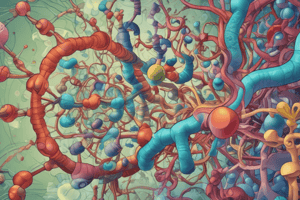Podcast
Questions and Answers
What is the typical ratio of carbon, hydrogen, and oxygen atoms in carbohydrates?
What is the typical ratio of carbon, hydrogen, and oxygen atoms in carbohydrates?
- 1:2:1 (correct)
- 1:1:1
- 3:2:1
- 2:3:1
Which type of carbohydrate is composed of three or more monosaccharides bonded together?
Which type of carbohydrate is composed of three or more monosaccharides bonded together?
- Polysaccharide (correct)
- Disaccharide
- Oligosaccharide
- Monosaccharide
What is the primary function of carbohydrates in the body?
What is the primary function of carbohydrates in the body?
- To produce red blood cells
- To store glycogen in the liver
- To provide structure and support
- To provide energy for the body (correct)
Which of the following is an example of a plant-based source of carbohydrates?
Which of the following is an example of a plant-based source of carbohydrates?
What is the importance of carbohydrates for brain function?
What is the importance of carbohydrates for brain function?
Where are excess glucose stored in the body?
Where are excess glucose stored in the body?
What is the enzyme responsible for breaking down carbohydrates in the mouth?
What is the enzyme responsible for breaking down carbohydrates in the mouth?
What is the importance of carbohydrates for red blood cell function?
What is the importance of carbohydrates for red blood cell function?
What is the typical fate of excess glucose in the body?
What is the typical fate of excess glucose in the body?
What is the importance of fiber intake?
What is the importance of fiber intake?
Study Notes
Overview
- Carbohydrates are a type of biomolecule that provides energy to the body
- They are composed of carbon, hydrogen, and oxygen atoms, usually in a ratio of 1:2:1
Types of Carbohydrates
- Monosaccharides: simple sugars, cannot be broken down further
- Examples: glucose, fructose, galactose
- Disaccharides: composed of two monosaccharides bonded together
- Examples: sucrose (glucose + fructose), lactose (glucose + galactose)
- Polysaccharides: composed of three or more monosaccharides bonded together
- Examples: starch, cellulose, glycogen
Functions of Carbohydrates
- Energy source: broken down into glucose for energy production in cells
- Structural role: provide structure and support in plants (cellulose) and animals (chitin)
- Glycogen storage: stored in liver and muscles for quick energy release
Sources of Carbohydrates
- Plant-based sources: fruits, vegetables, grains, legumes
- Animal-based sources: milk, honey, lactose-containing products
- Refined sources: sugar, white bread, pasta, baked goods
Importance of Carbohydrates
- Brain function: primary source of energy for the brain
- Red blood cell function: necessary for production of red blood cells
- Fiber intake: important for digestive health and satiety
Carbohydrate Digestion and Absorption
- Mouth: carbohydrates broken down into simpler sugars by salivary amylase
- Small intestine: carbohydrates broken down into monosaccharides by pancreatic amylase and absorbed into bloodstream
- Liver: excess glucose stored as glycogen or converted to fat for storage
Carbohydrates
- Biomolecules that provide energy to the body
- Composed of carbon, hydrogen, and oxygen atoms in a 1:2:1 ratio
Classification of Carbohydrates
Monosaccharides
- Simple sugars that cannot be broken down further
- Examples: glucose, fructose, galactose
Disaccharides
- Composed of two monosaccharides bonded together
- Examples: sucrose (glucose + fructose), lactose (glucose + galactose)
Polysaccharides
- Composed of three or more monosaccharides bonded together
- Examples: starch, cellulose, glycogen
Functions of Carbohydrates
Energy Source
- Broken down into glucose for energy production in cells
Structural Role
- Provide structure and support in plants (cellulose) and animals (chitin)
Glycogen Storage
- Stored in liver and muscles for quick energy release
Sources of Carbohydrates
Plant-Based Sources
- Fruits, vegetables, grains, legumes
Animal-Based Sources
- Milk, honey, lactose-containing products
Refined Sources
- Sugar, white bread, pasta, baked goods
Importance of Carbohydrates
Brain Function
- Primary source of energy for the brain
Red Blood Cell Function
- Necessary for production of red blood cells
Fiber Intake
- Important for digestive health and satiety
Carbohydrate Digestion and Absorption
Mouth
- Carbohydrates broken down into simpler sugars by salivary amylase
Small Intestine
- Carbohydrates broken down into monosaccharides by pancreatic amylase and absorbed into bloodstream
Liver
- Excess glucose stored as glycogen or converted to fat for storage
Studying That Suits You
Use AI to generate personalized quizzes and flashcards to suit your learning preferences.
Description
Learn about the composition and different types of carbohydrates, including monosaccharides, disaccharides, and polysaccharides.




